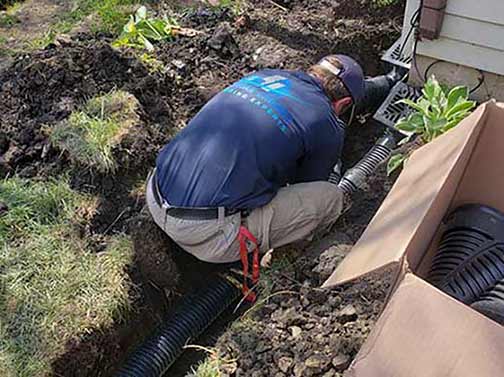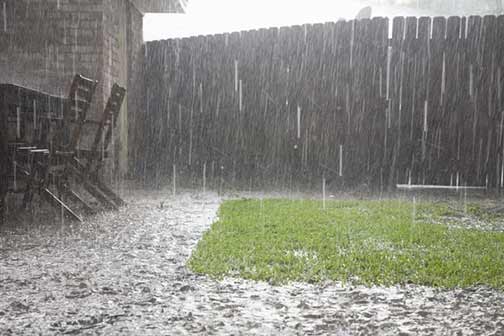Comprehending the Importance of Protecting Your Home’s Foundation on Rainy Seasons
The foundation of a home is likely its most critical structural part, as it is tasked with maintaining the entire building stable and supported. It is the skeleton that supports the very survival of the house, keeping it erect, solid, and safe for the long-term. During rainy seasons, this essential part of your property is exposed to increased risks of water intrusion, soil erosion, and plumbing issues due to the inability to drain water effectively.
Realizing the necessity of safeguarding your foundation as a means of maintaining your home in good shape and preventing exorbitant repair bills in the future is inevitable. Below we aim to provide homeowners with thorough, trustworthy information on how to effectively protect your foundation during wet weather conditions, emphasizing preventative measures that can really make a difference in the longevity and safety of your home.
Learning How Rain Affects Your Home Foundation
Rain affects a home foundation primarily through water seepage and soil movement. Rainwater, if not directed away from the home well, gets into the ground around the house in opposition to the foundation, and it generates a host of issues. The ground becomes overloaded with water sooner or later, making it weaker and causing it to shift in and out with repeated ground expansion and shrinking—soil erosion. This movement leads to shifting and settling, which often appears in the form of cracks, uneven floors, and misaligned doors and windows.
The persistence of moisture around the foundation could lead to building materials deteriorating and even result in basement flooding and mold growth, which compromise structural integrity. The effects of rain on a foundation are cumulative; low amounts of water penetration, if left untreated, will ultimately lead to observable damage over decades of exposure. Understanding these mechanisms reinforces the importance of using proper water management strategies to protect your house during rainy seasons.
Identifying Signs of Rain-Caused Foundation Damage
It is necessary to spot signs of foundation damage caused by rain early enough to allow for early intervention. Homeowners should look out for visible cracks in interior or exterior walls, especially those that are horizontal or spider web in nature. Doors and windows that stick and used to close well are an indication of foundation movement. Dips or tilting floors are also common signs of underlying problems.
Additionally, water pooling around the house foundation, wet or moldy patches in the basement or crawl space, and mildew odors can all be signs of water infiltration. If these signs are noticed, it’s important to act fast so that minor issues don’t become full-blown structural failures. Addressing foundation problems earlier than later not only rescues your home’s value and safety but also reduces the cost and complexity of repairs. Having regular checks, especially after heavy rainfall, is an excellent way of detecting emerging problems early and keeping your home foundation healthy.
Installing Sufficient Drainage Methods to Direct Water Away from Your Home
Proper drainage is the cornerstone of protection of your house foundation from water damage during rainy seasons. Maintaining well-installed gutters and downspouts directs rainwater from the building in a timely manner. Siting downspouts several feet away from the foundation is crucial to allow water to drain away from the base of the building. Also, grading the yard around your home so the ground slopes away from the foundation enables natural water flow off, reducing the likelihood of water buildup and soil erosion.
Regularly cleaning gutters and downspouts following storms and during rainy periods is essential to prevent clogging that results in overflows and water damage. In some cases, installing additional drainage systems such as French drains or surface drains can provide additional water diversion. All together, these measures ensure that water is directed away from the building foundation, lessening the pressure on the soil and avoiding the risk of water penetration and damage to the building.

Maintaining Your Landscaping to Promote Healthy Water Runoff
Don’t forget that landscaping is vital in foundation protection as it will manage the way water flows around your home. Landscaping will direct water away from the home and will not permit water to accumulate near the foundation. Do not install water plants or mulch beds close to the foundation because these will attract moisture and will make the seepage of water push out. Instead, choose well-drained soil and drought-resistant native plantings that will soak up excess water. Incorporating landscape features such as swales—shallow, wide waterways to divert water—or French drains can also facilitate smooth water runoff.
Both of these features help to relieve pressure on the foundation by steering water away from vulnerable spots. Mulching, when well done, also helps in the retention of soil moisture and protection against erosion but should be kept away from foundation walls. Ongoing monitoring and readjustment of your landscape will keep water control in line, especially during heavy rains, and aid in overall foundation stability of your residence.
Sealing Cracks and Vulnerable Spots in Your Foundation
Foundation or basement wall cracks are common signs of stress caused by water intrusion and soil shifting. Sealing the cracks with high-quality epoxy or polyurethane sealants will prevent water from entering your foundation and continuing to damage it. It is a simple and inexpensive repair to apply a sealant for smaller cracks. But more extensive or larger cracks must be professionally evaluated to determine whether or not structural underpinning or bracing is necessary.
If cracks are ignored, they will result in further deterioration, additional intruding water, and even eventual structural failure in the future. Regular inspection should be performed often, especially after hard rainstorms or freeze-thaw cycles, to find new or enlarging cracks early. Sealing and repairing these weak points immediately serves to preserve the integrity of your foundation, prevents water from approaching deterioration, and gives years of added life to your home’s structural system.
Extra Safety With Installation of Waterproof Barriers and Membranes
Waterproofing your foundation means that barriers will be installed here, which will prevent water from entering the walls of your structural work. Waterproofing from the exterior means usually excavating around the foundation and installing specialized membranes or coatings for water-proofing. This process works pretty effectively to stop water from entering before it gets to the foundation walls. Internal waterproofing methods, such as interior sealants and sump pumps, provide additional protection, especially in flood hazard areas or where it is difficult to perform exterior waterproofing.
Sump pumps actually pump out water that has accumulated in basements or crawlspaces, while interior sealants close up small leaks and prevent vapor intrusion. The use of both external and internal waterproofing measures offers complete protection against water intrusion during heavy downpours, leaving your home dry, solid, and mold and moisture free.
Utilizing Sump Pumps and Moisture Barriers to Hold Back Excess Water
Sump pumps are indispensable devices for basements that are prone to water invasion or those located in the flood area. Located in a sump pit at the basement or crawl space foundation, sump pumps actually pump excess water away before it leads to flooding and water damage. Regular maintenance, such as testing and cleaning the pump and its components, ensures efficiency when needed most.
Moisture barriers, such as vapor barriers installed on basement walls and floors, reduce moisture migration, delay mold development, and promote better indoor air quality. These systems work in harmony to control excess water, make a region beneath your home dry and stable, and protect your foundation from water related deterioration in heavy rainfall.
Regular Inspection and Maintenance for Long-Term Foundation Stability
Periodic inspection and maintenance are critical when keeping your home’s foundation stable, particularly during wet weather conditions. Visual inspections following a heavy storm can identify early indications of water penetration, soil erosion, or drainage system failure. Reinforcing drainage systems, sealing new cracks, and landscaping maintenance are routine tasks that significantly contribute to long-term stability. Regular involvement of professional foundation inspectors offers expert opinions that can identify potential problems before they get worse, enabling prompt repair and intervention.
Routine maintenance protocols—gutter cleaning, sump pump checkups, and regular landscape grading to ensure its continued effectiveness—are required to maintain long-term foundation health. By taking proactive steps, expensive repairs are avoided, structural integrity is maintained in your home, and safety and peace of mind are guaranteed for the long haul.
Emergency Preparedness in the Wake of Severe Rainstorms
Despite precautions, there remains a risk for severe weather conditions to impact your home’s foundation. An emergency plan with easy access to sandbags, portable pumps, waterproof tarps, and other flood protection equipment is valuable. Raising electrical circuits, appliances, and most valued items can prevent damage if flooding does occur. Having the proper insurance coverage and taking photos of your property before storms can make repairs and claims simpler down the line.
Knowing the weather reports and having a clear cut plan in place allows you to act swiftly and firmly when severe rainstorms hit. Having these plans and supplies in place can be a big help in keeping the surprise weather from having an impact, allowing you to protect your home as well as save on repair bills after severe storms.
Conclusion: Preemptive Steps toward a Safe and Secure Home
Protecting the base of your home during the rainy season requires an integrated approach that combines preemptive planning, routine maintenance, and timely repairs. Understanding the impact of rain on your home and appropriate utilization of effective drainage, sealing, waterproofing, and inspection strategies can actually help you mitigate water damage and structural issues. Bear in mind that a well-maintained foundation not only guards the safety and stability of your home but also preserves its value in the long term.
Embracing these steps with diligence and commitment will allow you to spend rainy seasons worry-free, knowing that your home is well protected against nature’s power. Last but not least, an investment in foundation protection is an investment in peace of mind, home longevity, and your family’s health, and thus on any prudent homeowner’s agenda.


